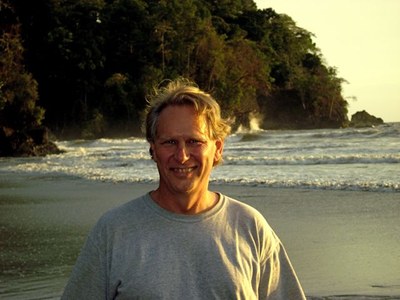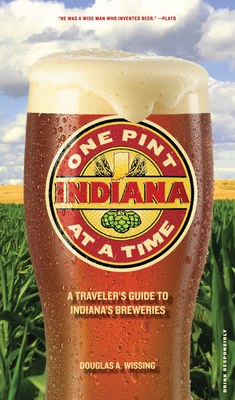
Plan your visit
Let’s Talk About Beer
July 14, 2010

A
Bloomington-based independent journalist and writer,Douglas A. Wissing, author of the new IHS
Press bookIndiana: One Pint at a
Time; A Traveler’s Guide to Indiana’s Breweries, brings some family
history to his work detailing the history and culture of the Hoosier State’s
brewing history. Wissing is a descendant of nineteenth-century Indiana-German
brewers. In the following interview, Wissing, who has covered the war in Afghanistan, reflects on his experiences writing
about Indiana’s
brewing past and present.
Did you know much about the history of beer
in Indiana before you began your research for Indiana: One Pint at a Time?
From growing up in southern Indiana,
I had experience with later industrial beers brewed in Evansville,
Fort Wayne and South Bend,
and knew about some of the historical breweries dotted around the state,
including one called Hack and Simon in my hometown of Vincennes, where there are still some old
brewery buildings. But not much beyond that.
When I began research on the book, it was a big
shock to eventually figure out that more than 500 breweries have operated in
the Hoosier State
since theHarmonistsbegan
the Indiana
brewing tradition in 1816.
 Were there any individuals in Indiana?s early beer
Were there any individuals in Indiana?s early beer
history that caught your attention?
Some of the pioneer brewers captured my fancy:
George Bentel, the German utopianist who was the brewer for the Harmonist communards
in New Harmony. He was the first brewer in Indiana, and his house still stands on Brewery Street in New
Harmony. It was very cool to track down one of his recipes, which
theBrewers of Indiana
Guild today’s organization of Hoosier craft brewers used for their
“replicale” for this year. About 10 craft brewers around the state
brewed Bentel’s recipe for a dark lager, so as part of the book kick-off,
Hoosiers can drink Indiana’s
First Beer this summer.
There was another early brewer who was associated
with the second New Harmony communal
experiment that followed the progressive ideas ofRobert Owen. His name was
Hew Ainslie, who was an iconoclastic Scottish poet who’d followed his dream to
frontier of Indiana.
He became a well-regarded brewer in New Albany,
while continuing to parse the poesy of his years on the Wabash River.
And of course there was Ezra Boswell, a one-eyed
Quaker brewer who opened Indiana’s second
brewery in Richmond
in late 1817. Boswell learned his trade in Great Britain, before migrating to
the Quaker town.
Beyond being a brewer and father of eleven
children, Boswell was a town leader, as the citizens elected him as town clerk
and later onto the board of trustees. Richmond
was a straight-laced town, so there was some “tongues of slander”
when it became known the trustees were drinking Boswell’s brews at town
expense.
How much traveling did you do to research
microbreweries now in the state?
Oh, I wandered all over the place. Beyond my trips
to research archives and locales about historical breweries, I visited all the
contemporary craft brewery operating in the state at the time almost three
dozen at this point. This is the most breweries operating in Indiana since Prohibition.
Was there anything that surprised you about
beer in Indiana
during your research?
I had a funny experience down in Vincennes, where I descended from French and
Alsatian-German stock. I was in the public library looking at an
early 20th-century county history, the type that include biographies and
engraved photos of the leading businessmen and professionals of the day. It is
a good source of information on historic breweries, as they were often one of
the major industries in town. I was looking for info on the Hack and Simon
Brewery, which was a big regional player with a brewery that stretched a couple
of blocks long near what is today theVincennes
Universitycampus.
I was flipping through this 100-year-old
county history, when I suddenly encountered a photo of my father or so I first
thought. After I got over the disjuncture of seeing what I thought was a
totally impossible picture, I learned it was a picture of my great-grandfather
John Ebner. (They always said my long-deceased father looked like the Ebner
side of the family.) As I read the bio, I realized John Ebner was the founder
of the Hack and Simon brewery, first naming Eagle Brewery before leasing it to
Hack and Simon. I never knew he was a brewer, though he had a mansion in Vincennes, which was
typical for the Indiana-German brewers of the heyday of lager brewing. I
learned John Ebner was an Alsatian, who’d served in the French Foreign Legion
in Africa before immigrating here. Made me
think I came by both my wanderlust and love of beer honestly.
Have you ever tried to homebrew?
I believe I am one of the worst homebrewers ever.
I have brewed horrible beer beer so bad not even my son’s post-college
rock-and-roll band,Johnny Socko,
would drink it. Those guys would drink any virtually free beer, so it was a
real sign that I needed to stick to writing about beer, rather than trying to
actually brew it. I think the world is a better place for that decision.
What is your favorite Indiana beer?
I’m not being coy when I say I don’t have a
favorite Indiana
beer. There are just a lot of great beers being brewed across the state. Many
folks know that theThree Floyds
Breweryin Munster was rated the top
brewery in the world, as well as having their Dark Lord imperial stout being
ranked as the world’s best beer. But that’s just the start. Hoosier brewers up
and down the state are brewing world-class beer and getting recognized for it.
And we get to drink.
__________________________








